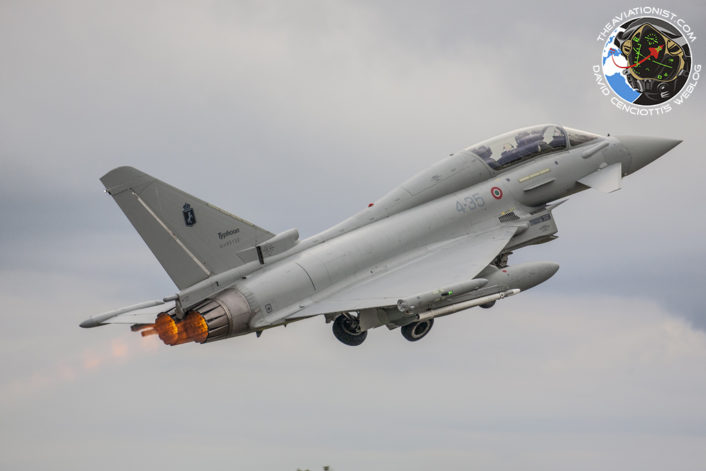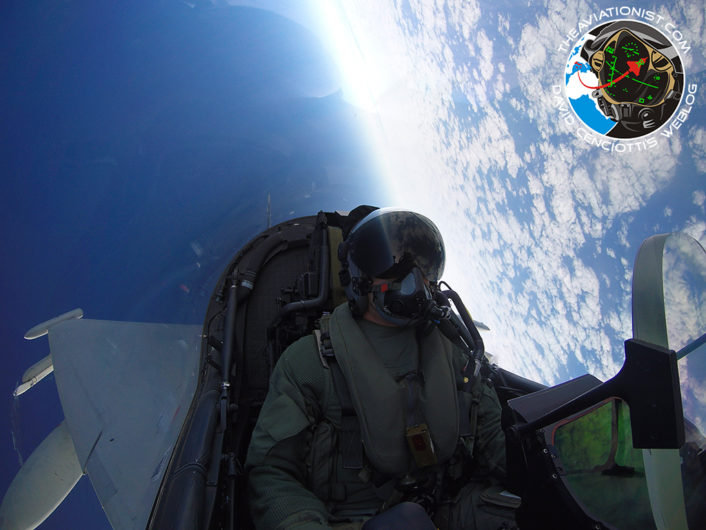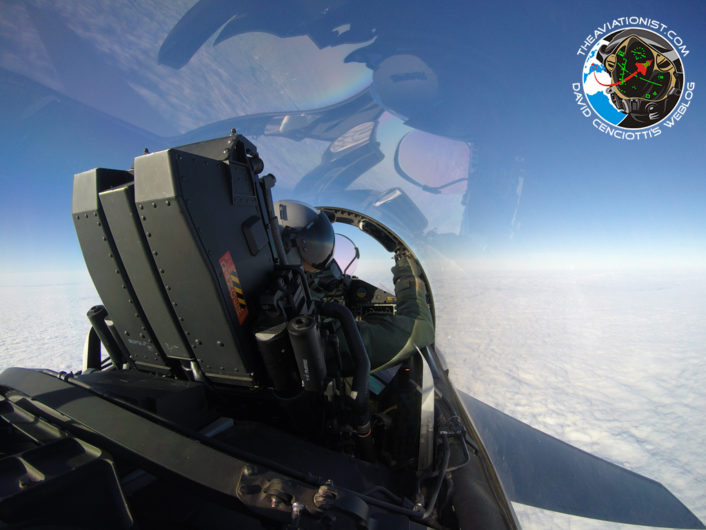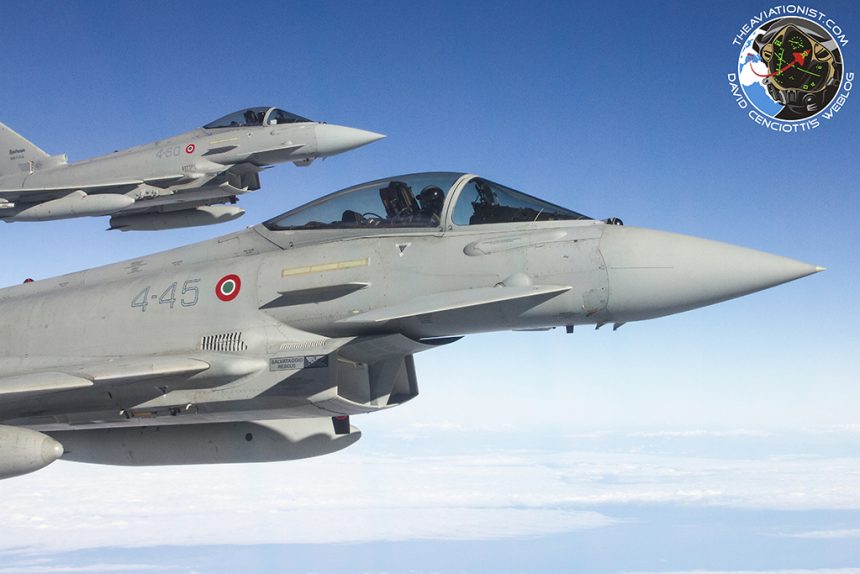We have had the opportunity to fly in one of the world’s most advanced fighters to experience the thrills and complexity of a 4 vs 3 supersonic aerial combat training exercise.
Much has been said about the Eurofighter Typhoon and its air dominance capabilities.
Its superb engine-airframe matching and maneuverability, in combination with its High Off-Bore-Sight armament supported by Helmet Cueing “has already and consistently proven winning against any agile fighter.” Indeed, we have also widely reported about the outcome of some mock air combat engagements between the Euro-canard and the U.S. F-22 Raptor in a past Red Flag-Alaska during which the Eurofighters managed to score several kills (in a Within Visual Range scenario whose Rules Of Engagement are mostly unknown – please read the story we posted back then to put this in the right context.)
Anyway, since simulated kills and HUD captures scored during air superiority training say little about the way a 4.5 Gen fighter plane fights (unless we have an in-depth knowledge of the actual ROE) we visited the 4° Stormo (Wing), the most experienced Eurofighter wing in the ItAF and one of the units of reference at international level among the Typhoon partner nations as well as a recognized leader in the process of optimizing the weapon system, to fly in a Eurofighter Typhoon (or F-2000 as the aircraft is designated by the Italians) during a complex air-to-air training mission.
And here’s the first hand account of what it looks like to fly and fight in the Typhoon.
Dardo 03
I’m attending the briefing of “Dardo 02-03”, the mission that I will have the opportunity to “observe” from the backseat of the TF-2000A (Italian’s two-seater designation) serialled MM55132/“4-35” and belonging to the 9th Gruppo (Squadron).
The mission is the final FCR (Full Combat Readiness) check for two pilots of the Squadron responsible for the air policing of all central and northern Italy, and Slovenia. For this reason, it’s going to be long, difficult and “crowded”, as it will involve as many as 7 Typhoons, in a 4 vs 3 scenario.
“This is the apex of the training carried out at the Squadron,” says Federico, 9th Gruppo Commander and pilot of the only two-seater in today’s mission. “No other training sortie is as complex as the one required to determine whether a LCR (Limited Combat Readiness) pilot is ready for combat: it includes multiple real-life scenarios that require the two examinees to successfully conduct BVR (Beyond Visual Range) intercepts, visual identifications on the “bogeys” as well as WVR (Within Visual Range) air combat against three Typhoons that will emulate the flying characteristics and tactics of the “super-maneuverable” Su-30 Flanker.”
We will play the role of one of those Flankers as part of the Red Air (“Dardo 03”) whereas the examinees will fly as wingmen (#2 and #4) to two experienced pilots in the 4-ship Blue Air (“Dardo 02”). Noteworthy, the “good guys” will also wear the HMSS Mk2, a futuristic helmet that provides the essential flight and weapon aiming information through line of sight imagery: information imagery (including aircraft’s airspeed, altitude, weapons status, aiming etc) are projected on the visor (the HEA – Helmet Equipment Assembly), enabling the pilot to look out in any direction with all the required data always in his field of vision. We will operate inside the D115, a large working area located over the Tyrrhenian Sea suitable for supersonic flying and for use of chaff and flares, under positive radio and radar control of a GCI (Ground Controlled Intercept) site. The Red Air will depart first and wait for the Blues inside the area.
After a common briefing that covered the basic details of the flight (weather, launch and recovery procedures, emergencies, radio channels, transponder codes, etc.), the Blue and Red team split for the (classified) tactical briefing while I’m introduced to the Typhoon’s peculiar flight gear, a mix of British and American-style equipment. The flight helmet I’ll wear is a Gentex ACS (Aircrew Combat System) a lightweight, dual visor HGU-53/P derivative, with the EFA/ACS oxygen mask and the typical inflatable bladder system that acts on the nape and whose aim is to prevent the G-induced Loss of Consciousness (GLOC). I’m also given a survival jacket, the anti-g pants and, since the water temperature is 13° C, I’m also assigned a Tacconi neoprene watertight suit. I’m ready. I join the rest of the Red Air as we step to the aircraft, parked in the apron next to the 9° Gruppo. In a few minutes I find myself strapped in, with Federico copying the ATC clearance on the radio while taxing to the active runway. The plan is to perform a high-performance take off followed by a RAT (Radar Assisted Trail) and subsequent southbound navigation towards D115.
We enter runway 03 and line up, waiting for the other two “bad guys” to reach us. We will take off in sequence, with 10 seconds separation between us. With the three Typhoons aligned on the tarmac we perform the engine checks. All is ok.
“Tower, Dardo 03, ready for take off,” Federico radios. The answer immediately arrives: “Dardo 03, Grosseto Tower, you are cleared to a high-performance take off, wind is calm.”
Let’s rock and roll. The throttle jerks to the full afterburner position and the Typhoon starts rolling. In spite of the two drop tanks that we carry on the underwing pylons, in less than 10 seconds we reach 120 knots and rotate.
“Number 1 is airborne!”.


Federico retracts the landing gear while gradually pulling the stick.
With a nose up pitch attitude of 50 degrees over the horizon, we continue to accelerate to report FL310 inside Grosseto CTR (Control Zone) following the assigned SID (Standard Instrumental Departure) that will soon bring us over Giglio Island. The rate of climb is impressive.
As we continue to climb followed by the other two Typhoons in radar-trail, I take a chance to get accustomed to the glass cockpit. The TF-2000’s backseat is quite large and comfortable. The most eye-catching thing is the wide-angle HUD (Head Up Display) with the typical green color over the whole screen. Fed by a camera in the front one, the HUD makes you fill like you are sitting at the front seat: not only does it show the same symbology but it also provides a video of the forward view (that otherwise would be obstructed by the front ejection seat). The front panel features three full colour multi-function head down displays (MHDDs) that can be arranged at will to show the system status, the nav menu, the weapons selection, as well as the moving map.

We climb to FL360 in a fighting wing formation and after about 30 minutes, we reach D115. As planned, we proceed towards the southern part of the area. It’s time to perform the G check during which the low-breathing resistance of the mask along with the helmet’s inflatable bladder prove to be particularly useful: we accelerate to 480 knots, make a right 90-degree turn pulling 5 G, followed by a left 90-degree turn back on course, pulling another 5 G. I’ve survived this, hence we are ready to start with the first BVR exercise.

Approaching the southern border of the area we turn northbound to meet the “Blue Air” that has just entered D115. We split the formation spacing the planes by several miles, with altitudes from 5,000 to 50,000 feet, proceeding head-on against the hostile aircraft while the friendly GCI controller provides details about their position, speed and altitude. The first exercise is quite fast: the ability of the two young examinees to use the powerful Captor radar is assessed in a matter of few minutes: the simulated use of three radar-guided missiles ends the first engagement and we can move on to the second one. Once again we proceed southbound as the Blue Air heads north to achieve the required spacing. Before reaching the boundary of D115 we turn back again towards the furball.

We climb to FL460 and accelerate past Mach 1. Thanks to the supercruise capability of the Typhoon we keep a supersonic speed without using reheat. This time the exercise includes WVR (Within Visual Range) air combat, during which the examinees can exploit the HMSS Mk2 to achieve a good kill on the Aggressors in accordance with the ROE that were established for the mission.

“Although the future scenarios demand for stealth fighters capable to engage hostile aircraft from long distances, the real operations we have taken part so far still require the interceptors to come within visual range of the enemy plane to perform a VID (Visual Identification): this means that air combat at close range remains an eventuality and, as such, we have to train to exploit the aircraft and its sensor at best in WVR engagements.”
Ok, we can prepare for the last exercise during which the Red Air elements “pop up” from lower altitude as if they were just launched from a QRA base and are engaged by the Typhoons CAPping at higher altitude.
We’ve finished dogfighting, it’s time to head home.

The Aggressors will RTB (Return To Base) first, followed by the Blue Air: not only do we have less fuel but we also need to vacate the runway in time for them to practice some emergencies. We enter the Grosseto CTR at FL360 and start our descent in close formation in IMC (Instrumental Meteorological Conditions): “although this is randomly practiced, this kind of approach is useful in case of electrical failure,” says Federico as we break the overcast weather and get in sight with the ground. We cancel the IFR (Instrumental Flight Rules) flight plan and continue in VFR (Visual Flight Rules) to the Initial Point of the visual pattern for runway 03.

The downwind leg, base turn and subsequent landing are extremely smooth. Maintaining the nose-up attitude after the touchdown Federico shows me the efficient aerodynamic braking ability of the Euro-canard. We clear the runway and reach the apron of the 9th Gruppo after 1h 50 minutes of flight.
As I’m greeted by the ground personnel of the squadron after my first hop in a Typhoon, the 4-ship Blue Air arrives overhead. Among them, two newly qualified FCR pilots.

Related articles
















